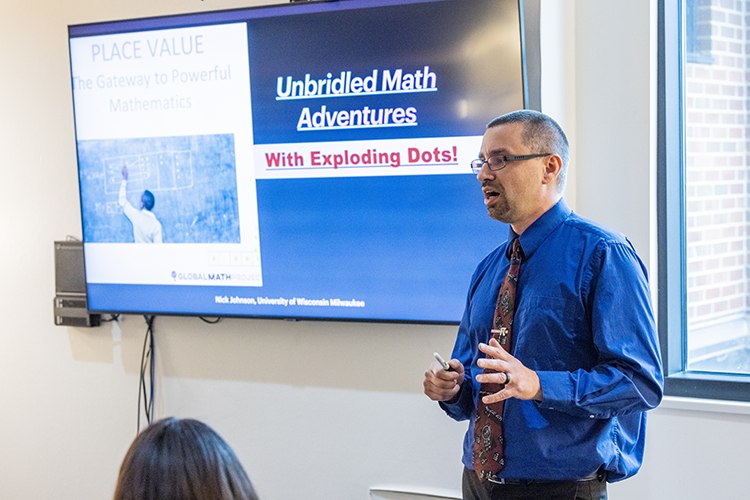Nick Johnson liked mathematics only “a little bit” in high school and didn’t think he was cut out for college. “I never saw myself going to college. My parents didn’t go to college, and we just never had the money.” His last high school mathematics class, pre-calculus, was in 1999, and he dropped it because “I couldn’t understand anything, and I didn’t need it for graduation.”
That’s changed, thanks largely to the concept of exploding dots.
Johnson, who is a math specialist in the College of General Studies’ First Year Bridge program, recently gave a presentation on the topic of exploding dots at the National Council of Teachers of Mathematics in Washington, D.C. “It’s the Super Bowl of mathematics education,” he said.

In his current role as a math specialist, he is helping other students on their journeys to understanding and enjoying mathematics.
The bridge program provides help to students whose math skills aren’t quite up to college level yet, giving them the support they need. Students also work with a self-paced online program called ALEKS.
Johnson’s own journey to becoming an instructor gives him an understanding of ways to reach his students. He believes when students see mathematics as approachable and enjoyable, their confidence greatly increases and their understanding of mathematical concepts and ideas soars.
After suffering an injury while working at a printing company a few years out of high school, he decided to change his career path. “I was out to dinner with my wife and said, ‘Maybe I’ll finally go to college. I kind of like math a little bit.’”
He started in the bachelor’s program in mathematics education at UWM. At the same time, he began educating himself about the field of mathematics, going to the library and searching the internet.
“I remember going to the library and getting this book, ‘Pre-calculus Demystified.’ I was teaching myself and found some stuff online.”
How it works
Along the way, he discovered the concept of “exploding dots,” championed by mathematicians James Tanton and Sunil Singh, who were involved with the Global Math project . Exploding dots uses a visual approach involving boxes and dots to show how mathematics, particularly place value, works. Students put a dot in a box, and when they add another dot representing a certain number, the dots explode and go into a box to the left, representing a different grouping. Sound effects contribute to making the mathematics playful and fun.
A blog on exploding dots explains the idea in terms of counting coins. If a student has 12 dimes and 12 pennies, the 12 pennies can be dots in the far right hand side box. The pennies can then be exploded into the next box on the left to make another dime, leaving two pennies in the first box. Ten of the dimes can then be exploded into the next box on the left, making $1, leaving 3 dimes, and making a total of $1.32.
This example uses base 10, but exploding dots can be used with other bases, including base 2, which is helpful in working with computers. The concept can also be used in higher levels of math, ranging from long division to working with polynomials in high school and college-level courses, according to Johnson. Advanced algebra with polynomials is no different nor harder than grade school arithmetic, Johnson said.
After completing his bachelor’s degree in math education, Johnson decided he might not want to be a high school teacher, but he did enjoy tutoring. He decided to focus on mathematics for his master’s degree at UWM. He continued exploring the ideas behind the exploding dots in his thesis, titled “Exploring the Division Algorithm in Euclidean Domains with Exploding Dots.”
Johnson has now been working with students in the bridge program for four semesters. He has given presentations on exploding dots to a number of regional mathematics conferences, and sent a proposal for a talk on the topic to the math teachers council in the spring. He’s thrilled that it was accepted, and that he got to present in D.C.
Meeting his math heroes
Along the way, he’s had a chance to meet his math heroes Tanton, “the main dude behind exploding dots,” and Singh. He also has a collection of mathematics T-shirts, including one that reads “17 is a palindrome in base one-and-a-half.”
His goal is to help his students move from noncredit math courses to credit courses and beyond with a better understanding of the way mathematics works, said Johnson. “I can relate. I know what it’s like to sit in a math class and have no clue what’s going on.”
One of the challenges in his classes, he said, is reaching out to students who’ve had bad experiences with math or find it boring.
“Any subject, if you enjoy learning it, you’re going to do well. My main focus is to get every student to believe that they can do math, that they can enjoy learning math. It’s not going to be an awful struggle.”








